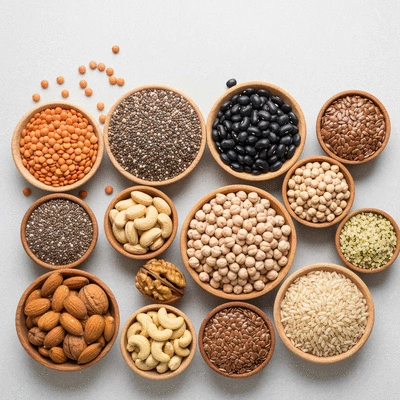Alternative Proteins Definition
Non-traditional sources of protein, including plant-based and innovative products like cultivated meat.

As the demand for sustainable living grows, so does the interest in alternative proteins. What if you could diversify your protein sources while supporting both your health and the planet? Here’s what you need to know about these innovative options!
Delve into the diverse world of alternative proteins with this visual guide, highlighting different sources and their key characteristics.
Non-traditional sources of protein, including plant-based and innovative products like cultivated meat.
Derived from plants; rich in nutrients, environmentally friendly.
Cutting-edge food technology for sustainable meat production.
Traditional food source in many cultures, gaining Western acceptance.
Unique alternative offering familiar taste and texture with health benefits.
Driven by technology (Cultured Meat, Precision Fermentation, Vertical Farming) and consumer trends (increased demand, transparency, culinary exploration).
As we navigate the ever-evolving landscape of nutrition, alternative proteins are becoming a central topic of discussion. Whether you're curious about incorporating more plant-based options into your diet or just looking to diversify your protein sources, understanding what these alternatives entail is crucial. Let's dive into the essentials!
Alternative proteins are generally defined as non-traditional sources of protein that include both plant-based options and innovative products like cultivated meat. These proteins are not just a trend; they represent a shift towards more sustainable eating habits that can contribute to both personal health and the well-being of our planet.
To clarify, plant-based proteins are derived from plants, encompassing a wide variety of legumes, grains, nuts, and seeds. In contrast, alternative proteins can also include novel sources such as lab-grown meat and insect proteins. Both categories aim to provide nutritious options that cater to diverse dietary preferences.
Understanding these definitions helps set the stage for exploring the various types of alternative protein sources available today. Each type comes with its unique advantages and challenges, making it essential to consider which fits best into your lifestyle.
Let’s take a closer look at the different categories of alternative proteins. It’s fascinating how many options are emerging, each with its own unique benefits and flavors!
Plant-based proteins are not only rich in nutrients but also come with the added benefit of being environmentally friendly. Recent reports highlight a significant shift towards these options, with the plant-based food and drink sector experiencing considerable growth, as detailed in this sector trend analysis. Popular sources include:
These options are incredibly versatile, making it easy to incorporate them into various meals. Plus, they contribute to a balanced diet, supporting energy levels and overall well-being. For more insights into the plant-based market, you can explore the State of the Industry report on plant-based foods.

Cultivated meat, or lab-grown meat, is at the cutting edge of food technology. Scientists cultivate animal cells to produce meat without raising and slaughtering animals. This process aims to reduce the environmental impact of traditional meat production while providing a familiar taste and texture. Exciting, right?
Although still emerging, cultivated meat presents a promising alternative for those looking to reduce their meat consumption while still enjoying the flavors they love.
In many cultures around the world, insects are a traditional food source, packed with protein and essential nutrients. While they may not be widely accepted in Western diets yet, the benefits are hard to ignore:
As awareness grows and culinary innovations increase, we may find insects becoming a standard protein source in diverse diets, perhaps right next to your favorite protein shake!
Mycoprotein, derived from fungi, is an intriguing alternative that offers a meat-like texture and is often featured in products like Quorn. It's not only a complete protein source but also low in fat and high in fiber! Integrating mycoprotein into meals can be a delicious way to experience the benefits of alternative proteins while enjoying a familiar taste.
As you can see, the world of alternative proteins is vibrant and full of potential. Whether you're an avid fitness enthusiast or just starting your wellness journey, embracing these options can provide exciting new flavors and health benefits!
Did you know? Incorporating a variety of alternative protein sources into your diet can enhance both nutritional value and flavor. For example, mixing mycoprotein with beans and nuts in your meals not only diversifies your protein intake but also adds unique textures and tastes, making your dishes more enjoyable and satisfying!
As we navigate the evolving landscape of nutrition, the future of sustainable proteins looks brighter than ever! With a growing awareness of health and environmental concerns, innovative technologies are emerging that promise to reshape how we produce and consume protein. The integration of science into food production not only opens the door to new sources but also holds the potential for significant advancements in sustainability.
So, what are these emerging technologies? From lab-grown meat to fermentation processes that create protein-rich ingredients, these innovations are redefining our options. Let’s explore a few key areas:
These advancements are just a glimpse of what’s to come as we move towards a more sustainable protein future. With these technologies, we can expect greater accessibility to plant-based and alternative proteins, empowering consumers to make healthier choices!
The landscape of alternative proteins is not just driven by technology; it’s also influenced by changing consumer behaviors. As a community at iFit Magazine, we’re committed to staying in tune with these trends to help guide our readers in their health journeys. Understanding these shifts can provide insights into how and why we are approaching our diets differently. The Health Council of the Netherlands, for example, has emphasized the importance of a healthy protein transition for future food systems.
Here are some notable trends to keep an eye on:
Incorporating these trends into our lives not only supports our health but fosters a deeper connection to our food sources. Embracing this shift is a journey, and we’re here to guide you every step of the way!

As we look to the future, one pressing issue stands out: the impact of climate change on food security. With changing weather patterns and increased extreme events, our agricultural systems face unprecedented challenges. This reality underscores the need for sustainable agriculture practices that prioritize resilience and adaptability.
At iFit Magazine, we advocate for methods that enhance food production while minimizing environmental impact. Some strategies include:
As we face these challenges, it becomes clear that embracing sustainable protein sources and practices is essential for securing our food future. Together, we can cultivate a healthier planet and a more nourishing lifestyle!
Now that we’ve explored the future of sustainable proteins, you might be wondering how to engage with this movement. Here at iFit Magazine, we believe that taking actionable steps is key to making lasting changes in our diets and lifestyles. Let’s dive into ways you can evaluate and choose sustainable protein sources!
Choosing the right protein sources can feel overwhelming, but it doesn’t have to be! Here are some simple tips to help you make informed decisions:
By following these tips, you can make choices that not only support your health but also contribute to a healthier planet!
Are you excited to learn more about sustainable proteins? There are numerous resources available that can help deepen your understanding and inspire you on your journey. Here are a few suggestions:
Engaging with these communities and resources not only enhances your knowledge but also connects you with like-minded individuals who are passionate about making a positive impact. Let’s dive in together and embrace the future of sustainable proteins!
Here is a quick recap of the important points discussed in the article:
Social Media's Impact on Well-being

As the digital landscape evolves, the nuances of social media's impact on mental health become incre
High-Protein Snacks for Muscle Growth

What if you could elevate your fitness journey simply by rethinking your protein intake? Understandi
Morning Workouts: Facts and Myths

What if the key to unlocking your fitness potential lies in the first hours of your day? Morning wor
Social Media's Impact on Well-being
High-Protein Snacks for Muscle Growth
Morning Workouts: Facts and Myths
Couch to Marathon: Real Journeys
Lifting Before Cardio: Fat Loss?